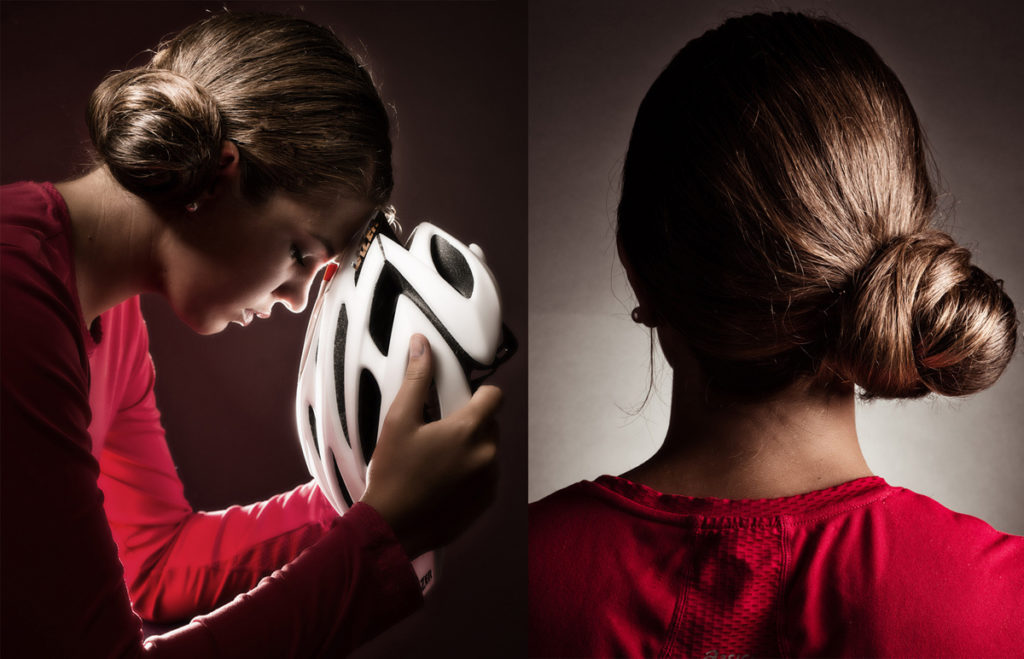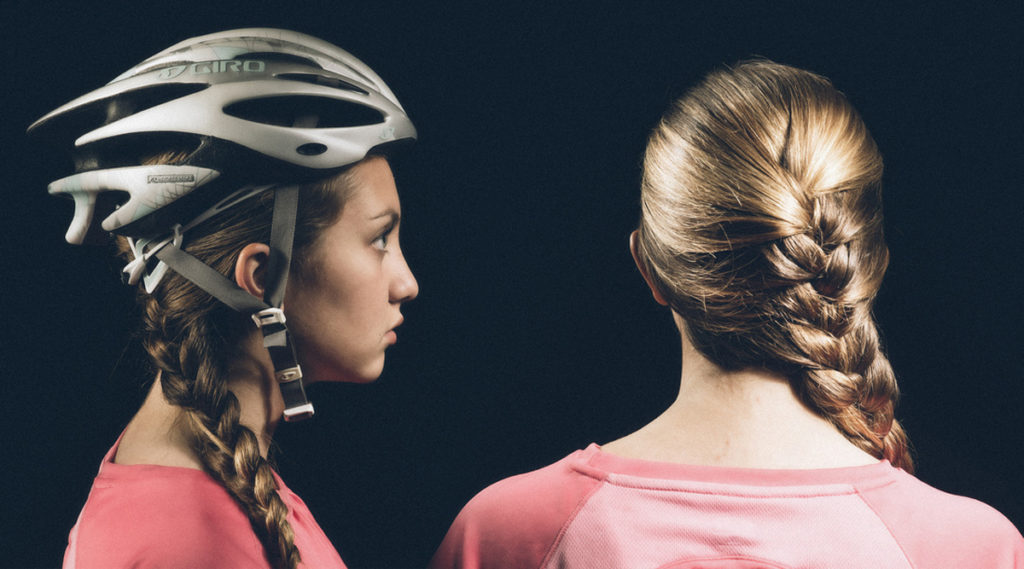By Tara McKee – Cycling is great for our mental and physical health, our earth, and our wallets, but we don’t always want to come into the office or show up for lunch with the girlfriends looking slightly disheveled from our ride. Does a commute by bicycle mean you can’t conform to professional norms with clothing, make-up and hairstyles? Is the thought of helmet hair and perspiration preventing many women from cycling? Actually, the answer is “yes”, and it is a big enough concern to be a barrier, but there are ways to prevent a helmet from ruining your ‘do and ways to pull off a quick Wonder Woman transformation into professional ready for a full day at the office.
 The girl in red shows a “Side Bun.” This hairstyle can be worn with a helmet and the hair will not have issues after the helmet is removed (i.e. no helmet hair.).
The girl in red shows a “Side Bun.” This hairstyle can be worn with a helmet and the hair will not have issues after the helmet is removed (i.e. no helmet hair.).Photo: Jon Diaz
Over the last decade a number of studies that have been conducted in Australia, the UK and Canada which mirror the few studies on the gender imbalances in bicycling done in the U.S. In all of these countries, men are about three times more likely to be regular cyclists than women. The studies continually showed that safety concerns were a big concern for women, even though men were much more likely to be involved in collisions when studied over equivalent time periods riding. (See BikesBelong.org which has links to many of these studies.) But the other issues of concern for women, especially for riding to work, involved the problem of carrying items while cycling and fears of being anything less than well-groomed in front of colleagues, clients or customers.
The August 2013 issue of Cycling Utah had a feature titled “A Women’s Guide to Commuting to Work” which covered the basics of commuting, including choosing the right bike for the commute and tips on how to carry items on your bike. One point that article brought up was that if your commute is a short one, you can easily ride in regular office attire, because you won’t be riding enough to work up a sweat. (It was really the “part one” of this article.) This article is focuses on those with a longer commute and tackles the issue of how to fight “helmet hair” and offers tips for that transformation from a biker into a credible executive.
The Quick Change
For a long commute, it is best to wear technical, athletic clothing for the ride and pack your work clothes in panniers. Most of the sweat will be in the clothes worn for the ride and you can remove most of that simply by changing your clothes. As an alternative to showering at work, many women use disposable body wipes or towelettes to remove sweat and excess oils from the skin. Some varieties can be used all over your body and some are gentle enough for the face. Stylist Suzanne Gallegos recommends Cetaphil Facial Cleanser which is a great product for wash and moisturizing the skin. It doesn’t require water. Just put some on your hands wipe across the face and towel off. At this point, you can just apply your make-up and some deodorant as usual.
If you really feel the need for a shower and your place of work does not have one, look around for a nearby alternative. Health and fitness clubs such as Planet Fitness or county recreation centers often offer low monthly memberships, a locker, and a place to shower. If you are fortunate enough to have such a place close to your place of work, you can use your commute as a pre-work training session and shower and change into your work clothes there.
Tips for clothes and shoes:
When packing your panniers: Roll, don’t fold, your clothes to avoid creases. Dresses are often a better choice for packing than a skirt and tailored shirt as the wrinkles fall out better. Silk dresses would not be the best choice to pack.
In your desk at work, keep handy a wrinkle-release spray such as Downy Wrinkle Releaser (available at most grocery stores). It works great for cotton blend clothes that may have a few wrinkles. Spray it, smooth the damp areas and the wrinkles will disappear. Rayon fabrics are a little more problematic though.
Find a dry cleaner near your office. Drop off some clothing articles (such as a silk dress) to be cleaned and pressed. Pick up your order a morning or two later to change into for work.
If possible, keep few pairs of heels, a good coat or suit jacket at the office to wear when needed.
Handling Helmet Hair
In the interest of protecting our fragile skulls while cycling, we wear helmets while riding. The padding on the inside of the typical helmet is composed of a poly knit over foam. The friction caused by the combination of poly-knit and foam across the cuticles of your hair often results in a less than desirable look: flattened, sweaty, and sometimes frizzy hair. But there are ways to prevent the dreaded “helmet hair” and they don’t require a complete wash and re-styling. Styling your hair before putting on the helmet and having a few essential hair products can make helmet hair a thing of the past.
 A simple French braid. Most women can manage to make this braid and again, it keeps the hair neatly in place for the duration of the ride. Photo: Jon Diaz
A simple French braid. Most women can manage to make this braid and again, it keeps the hair neatly in place for the duration of the ride. Photo: Jon DiazThink about it, the inside of your helmet gets dirtier over time, so wash it every so often. Keep your hair cleaner and your hairstyle protected by covering your hair under the helmet. Many women choose to wear a cycling cap or a Buff headband over hair and that will usually do the trick. But take a tip from French women and cover your hair under your helmet with a silk or satin headscarf. Not only will these fabrics reduce friction and protect hair from breakage and eliminate tangling, they are the best choice to absorb sweat, prevent helmet hair and preserve your style.
The first trick is to style your hair before putting on the helmet and there are a number of ways to do it. There are different hair types and styles and for each there are different tips and products. Find an experienced hairstylist and seek advice for how you can best style your hair for wearing under a helmet so it needs minimal care and styling upon your arrival at work. Whether you have curly or straight hair, short or long, there are ways to make sure you have a good hair day.
Tips for Great Looking Post-Ride Hair:
Pack a natural bristle brush. Right after removing your helmet, brush your hair out immediately with the brush. This will help lift your hair up and away from the scalp and help cool it down. Be sure to carefully work through the sweaty sections as this will allow your hair to dry at a maximum rate. Fluff it and style a little more if needed.
Dry Shampoo: This is a fabulous product for cleaning hair without getting it wet. Use the dry shampoo by working it into the roots of your hair and then brushing it out. There are some dry shampoos that work for mostly straight hair and some that work best for curly hair. Get a recommendation from your stylist or do some online research to find the type that will work best for your hair texture. It is a great post-ride remedy to remove sweat and city grime from your hair, but it also can be applied to the hair roots (do not brush out) before your ride to absorb excess oil and sweat during your ride. Applying before a ride will also keep volume and fight flatness.
Straight, longer hair tips: As you style your hair before your ride, part your hair on another side than your normal side. As you touch it up at work, you’ll part it in the normal side and you’ll find it won’t be as flattened. Pin up bangs to keep them off the forehead during the ride so they won’t absorb as much sweat. A pony tail is a great default hairstyle during the ride. Some women keep a cordless straightener (the kind most often used for travel) handy for a little touch-up.
Wavy, tousled look hair tips: Before your ride, apply dry shampoo at the roots and leave in. Next, spritz your hair with a wave-enhancing texturizer, separating and scrunching as you go. Then gather your hair at the top of your head and twist the hair into a messy bun. Secure the bun with bobby pins and cover with a scarf and the helmet. After you arrive at your destination, remove the helmet and bobby pins and simply shake out your hair. Voila! Beautifully tousled hair!
Curly hair: Many women with curly hair prefer riding with still-damp hair which has been piled on the top of the head under the helmet and then carefully fingering the curls into place upon arrival. The silk scarf can be helpful for reducing frizz. For very thick curly hair it may be easiest to pull the hair into a secured twist or pouf worn just below the helmet line.
Short hair: If you wear your hair short, you can work with your stylist to find an easy hairstyle that requires minimal post-ride styling. Get a good recommendation for hair products. For short hairstyles, some stylists recommend using wax and paste hair products instead of gels. Paste products give the hair texture, make it pliable and allow it to be re-shaped as needed. Several wax products are water-resistant and your hair won’t sweat them out. (Note to guys: this tip can for you too!)
Learn some new great hairstyles: Twists, braids and buns are popular hairstyles and many of them work well for wearing under a helmet. Learn how to do your hair up in a side ‘do, a sock-bun, chignon, or barrel roll and place it at the nape of your neck so it fits snugly below the helmet. There are great how-to videos on YouTube and you may find even more ideas through Pinterest.
Happy riding!
Special thanks to Suzanne Gallegos of Studios Salon at Brickyard.
Tara McKee was an editor for for the now-defunct cycleandstyle.com, an online women’s cycling magazine. This article originally appeared in the September 2013 issue of Cycling Utah.

